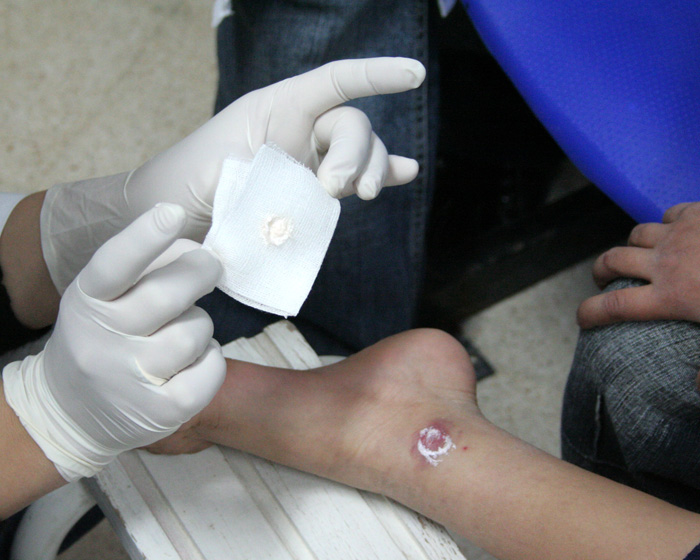Phase III Data Show Easy-to-Use Antibiotic Cream Has High Cure Rate, Few Side Effects in Treatment of Neglected Disease

Fort Detrick, Md. - An international collaboration of researchers from the U.S. Army Medical Research and Materiel Command, the Institut Pasteur de Tunis, the Tunisian Ministry of Health and the Institut Pasteur in Paris has demonstrated a high cure rate and remarkably few side effects in treating patients with cutaneous leishmaniasis with an investigational antibiotic cream. The results of the 375-patient trial were published today in the New England Journal of Medicine.
Cutaneous leishmaniasis is a parasitic disease that causes disfiguring lesions. It places 350 million people at risk worldwide, with 1.5 million new cases emerging annually, including U.S. service members serving abroad and the socio-economically disadvantaged in the developing world, especially children.
"A simple cream represents a tremendous breakthrough in the way we treat this neglected disease," said Maj. Mara Kreishman-Deitrick, product manager at the U.S. Army Medical Materiel Development Activity, which leads the advanced development of medical products for the USAMRMC.
In the Phase III study, investigators evaluated the topical cream that combined the two antibiotics paromomycin + gentamicin, known as WR 279,396. The results of the trial showed that the combination cream cured 81 percent of patients who participated in the trial, as patients experienced shrinking of the lesions, regrowth of normal skin and the absence of relapse, with less than five percent of all study groups reporting adverse events, which were primarily minor reactions at the applications site.
A cream containing paromomycin alone had a similar cure rate of 82 percent. Only 58 percent of patients receiving placebo had curing of lesions.
According to the researchers, a parity between the single and combination therapies was expected in this study, which treated CL caused by L. major, a parasitic species common in the Middle East and North Africa. However, they noted that the combination therapy could hold additional promise for global use since early research shows the combination therapy may be effective against the parasitic species found in Central and South America.
"With these results, we are on the verge of being able to provide non-toxic and easy-to-use treatments to the people who need them most, including U.S. service members," said Col. Max Grogl, director of the Division of Experimental Therapeutics at the Walter Reed Army Institute of Research.
The current treatments are not only expensive but contain toxic heavy metals that must be administered either intravenously or injected directly into the lesion for a 20-day course of treatment at a medical center. In the developing world, patients often resort to home remedies such as burning the lesions with anything from battery acid to a red-hot machete.
"Currently, patients must stay in a medical center for weeks to receive toxic and painful treatments," said Kreishman-Deitrick. "A cream would offer a safe, effective option that patients can apply themselves."
Since 2003, more than 3,000 CL cases have been reported among U.S. service members, who as a result are often evacuated from their posts – at an approximate cost of $35,000 for hospitalization, treatment and lost duty time per service member. WR 279,396 has the potential to become a first-line treatment that service members could apply themselves in the field.
USAMRMC and Institut Pasteur researchers formed a partnership 10 years ago around their common need for better CL treatments. Human transmission of CL has been seen as far north as Texas, and CL affects civilian travelers as well as U.S. service members. In Tunisia, where the Phase III clinical trial was conducted, up to 10,000 new cases are reported each year and more than half of these cases are among children.
"We are grateful to our international research partners for their dedication to developing a more tolerable CL treatment that will benefit patients around the world," said Grogl.
The U.S. Food and Drug Administration designated WR 279,396 as eligible for fast-track review, given CL's status as a neglected disease. The Fast Track program of the FDA is a process designed to facilitate the development and expedite the review of new drugs that are intended to treat serious or life-threatening conditions, and that demonstrate the potential to address unmet medical needs. USAMRMC is actively engaged with the FDA to support this review. Additional research also is being planned in Latin America to explore the effectiveness of the topical cream for treating the parasitic species found in the western hemisphere.













